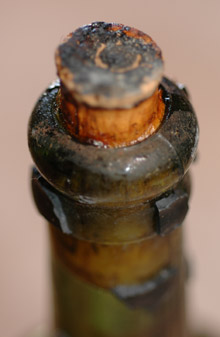 This is my contribution to the Session #37: “The Display Shelf: When to Drink the Good Stuff” or, if you prefer, “Raid the Cellar.” Visit The Ferm for links to more posts.
This is my contribution to the Session #37: “The Display Shelf: When to Drink the Good Stuff” or, if you prefer, “Raid the Cellar.” Visit The Ferm for links to more posts.
Is there a perfect beer for every particular special moment? Is there a time in every beer’s life when it tastes better than it ever otherwise will?
SirRon’s open-ended assignment for The Session spells certain trouble for me. I’m perfectly willing to spend all sorts of time contemplating questions that do not have answers.
Anyway, the topic this month seems particularly timely because we’ve recently been treated to a flock of stories about cellaring beer. Don Russell made it subject of his column last week, there was a story this week in The Washington Post food section, and a rather long feature in the Los Angeles Times (worth clicking through to for the photo alone).
Could this be dangerous? Although these stories emphasize the importance of picking the right kind of beers to lay down and having a proper cellar it’s easy to envision a reader skimming the story, grabbing who-knows-what beer, sticking it in the back of a closet and forgetting about it until it’s time for the next garage sale.
Last Christmas friends of ours brought out a large corked bottle of Budweiser that somebody had given them (thank goodness) at an estate sale. It was bottled in 2001 for the brewery’s 125th anniversary. We have no idea how it was stored, but that didn’t really matter. We opened it, sipped, talked about wet cardboard and dumped the contents. We could only dream about what that beer might have tasted like fresh.
 I must confess I’m a serial cellarer. When we moved to New Mexico and left our Illinois basement behind the idea was “no more laying down beer.” Didn’t take. Bought a chest freezer, hooked it up to a temperature controller and we were good to go.
I must confess I’m a serial cellarer. When we moved to New Mexico and left our Illinois basement behind the idea was “no more laying down beer.” Didn’t take. Bought a chest freezer, hooked it up to a temperature controller and we were good to go.
But only a small portion of beer spends much time in that pseudo cellar. We buy beer, we drink it. Beer shows up at our door, we drink it. It seems it would be rude to do so otherwise. Oh, that beer you sent last week, we’ll open it in 2014 and let you know how it is doing.
So a few things I learned in February:
The beers were really good, but you knew that. I liked XII better than a year ago, and we might have talked about that over the course of about two hours. I’m not sure. Not until I was driving home did I consider that three of us tasted Firestone 10 together, Firestone XI the next year, Firestone XII the next and now XI-XII-XIII.
We’re not some crusty war veterans who need an excuse to get together, but this is a nice little tradition that I expect will continue. So to SirRon’s question about “finding a drinking occasion that lives up to the reputation of the bottle,” I’d suggest sharing beer with friends should be occasion enough.
Tasted Firestone X, XI and XII on my anniversary with my wife. Baby boy on the way now. I tried to get them to put a warning on the next bottle that these things may happen.
I’m still holding on to 2 bottles of X, 2 bottles of XI, 5 bottles of XII and 5 bottles of XIII. Unfortunately we don’t have a beer fridge so the regular fridge is getting rather full. And now I’m cellaring Hale’s beers on top of it.
Being your friend in February alone would have been a good ride! 🙂
Thanks for the post.